
A barnacle is a type of arthropod constituting the subclass Cirripedia in the subphylum Crustacea, and is hence related to crabs and lobsters. Barnacles are exclusively marine, and tend to live in shallow and tidal waters, typically in erosive settings. They are sessile (nonmobile) and most are suspension feeders, but those in infraclass Rhizocephala are highly specialized parasites on crustaceans. They have four nektonic larval stages. Around 1,000 barnacle species are currently known. The name "Cirripedia" is Latin, meaning "curl-footed". The study of barnacles is called cirripedology.
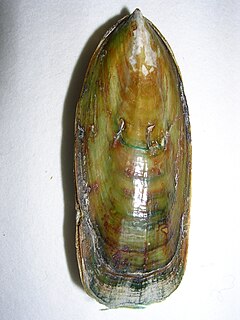
Lingula is a genus of brachiopods within the class Lingulata. Lingula or forms very close in appearance have existed possibly since the Cambrian. Like its relatives, it has two unadorned organo-phosphatic valves and a long fleshy stalk. Lingula lives in burrows in barren sandy coastal seafloor and feeds by filtering detritus from the water. It can be detected by a short row of three openings through which it takes in water (sides) and expels it again (middle).

Sea anemones are the marine, predatory animals of the order Actiniaria. They are named after the anemone, a terrestrial flowering plant, because of the colourful appearance of many. Sea anemones are classified in the phylum Cnidaria, class Anthozoa, subclass Hexacorallia. As cnidarians, sea anemones are related to corals, jellyfish, tube-dwelling anemones, and Hydra. Unlike jellyfish, sea anemones do not have a medusa stage in their life cycle.
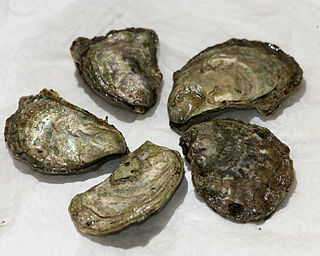
Ostrea lurida, common name the Olympia oyster, after Olympia, Washington in the Puget Sound area, is a species of edible oyster, a marine bivalve mollusk in the family Ostreidae. This species occurs on the northern Pacific coast of North America. Over the years the role of this edible species of oyster has been partly displaced by the cultivation of non-native edible oyster species.
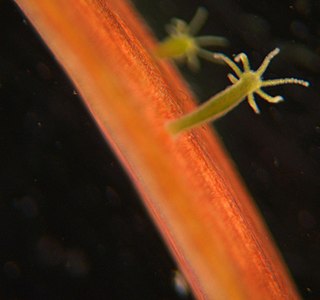
Sessility is the biological property of an organism describing its lack of a means of self-locomotion. Sessile organisms for which natural motility is absent are normally immobile. This is distinct from the botanical meaning of sessility, which refers to an organism or biological structure attached directly by its base without a stalk.
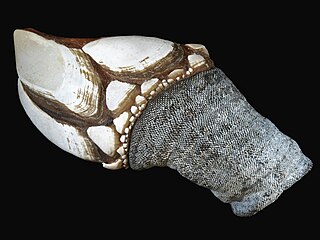
Pollicipes pollicipes, known as the goose neck barnacle, goose barnacle or leaf barnacle is a species of goose barnacle, also well known under the taxonomic synonym Pollicipes cornucopia. It is closely related to Pollicipes polymerus, a species with the same common names, but found on the Pacific coast of North America, and to Pollicipes elegans a species from the coast of Chile. It is found on rocky shores in the north-east Atlantic Ocean and is prized as a delicacy, especially in the Iberian Peninsula.

Diodora aspera, also known as the rough keyhole limpet, is a species of sea snail, a marine gastropod mollusk in the family Fissurellidae, the keyhole limpets. Although similar in appearance to a common limpet, it has a hole near the apex of its shell, and is only distantly related. It often has a scaled polychaete worm Arctonoe vittata living inside its shell as a commensal. In the event that it is attacked by a starfish, it extends flaps of mantle to defend itself, and the worm also helps drive the predator away.
Vermicularia spirata, common name the West Indian worm-shell or the West Indian wormsnail, is a species of sea snail, a marine gastropod mollusk in the family Turritellidae. Juveniles can move around, but larger individuals become sessile.

Amphibalanus amphitrite is a species of acorn barnacle in the Balanidae family. Its common names include the striped barnacle, the purple acorn barnacle and Amphitrite's rock barnacle. It is found in warm and temperate waters worldwide.

Lepas anserifera is a species of goose barnacle or stalked barnacle in the family Lepadidae. It lives attached to floating timber, ships' hulls and various sorts of flotsam.

Lepas anatifera, commonly known as the pelagic gooseneck barnacle or smooth gooseneck barnacle, is a species of barnacle in the family Lepadidae. These barnacles are found, often in large numbers, attached by their flexible stalks to floating timber, the hulls of ships, piers, pilings, seaweed, and various sorts of flotsam.
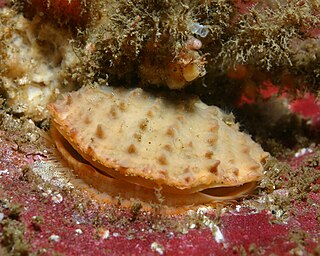
Crassadoma is a genus of rock scallops, marine bivalve molluscs in the family Pectinidae. It is monotypic, the only species being Crassadoma gigantea, the rock scallop, giant rock scallop or purple-hinge rock scallop. Although the small juveniles are free-swimming, they soon become sessile, and are cemented to the substrate. These scallops occur in the eastern Pacific Ocean.

Pollicipes polymerus, commonly known as the gooseneck barnacle or leaf barnacle, is a species of stalked barnacle. It is found, often in great numbers, on rocky shores on the Pacific coasts of North America.

Amphibalanus eburneus, the ivory barnacle, is a species of acorn barnacle in the family Balanidae. It occurs on the east coast of North America, the Caribbean Sea and Gulf of Mexico.
Alepas pacifica is a species of goose barnacle in the family Heteralepadidae. It is a pelagic species and is an obligate associate of various species of jellyfish. It mainly occurs in the Pacific Ocean.
Vulcanolepas osheai, commonly referred to as O'Shea's vent barnacle, is a stalked barnacle of the family Neolepadidae. This species is endemic to New Zealand.
Megabalanus californicus, the California barnacle, is a species of large barnacle in the family Balanidae. It is native to rocky coasts in the Eastern Pacific Ocean from North California to the Gulf of California.

Conchoderma virgatum is a species of goose barnacle in the family Lepadidae. It is a pelagic species found in open water in most of the world's oceans attached to drifting objects or marine organisms.

Clistosaccus is a genus of barnacles which are parasitic on hermit crabs. It is a monotypic genus, and the single species is Clistosaccus paguri, which is found in the northern Atlantic Ocean and the northern Pacific Ocean.

Astrapogon stellatus is a species of ray-finned fish in the family Apogonidae, the cardinal fishes. It lives in the tropical western Atlantic Ocean, the Caribbean Sea and the Gulf of Mexico. It is commonly known as the conchfish because it typically conceals itself in the mantle cavity of a living queen conch by day.
















